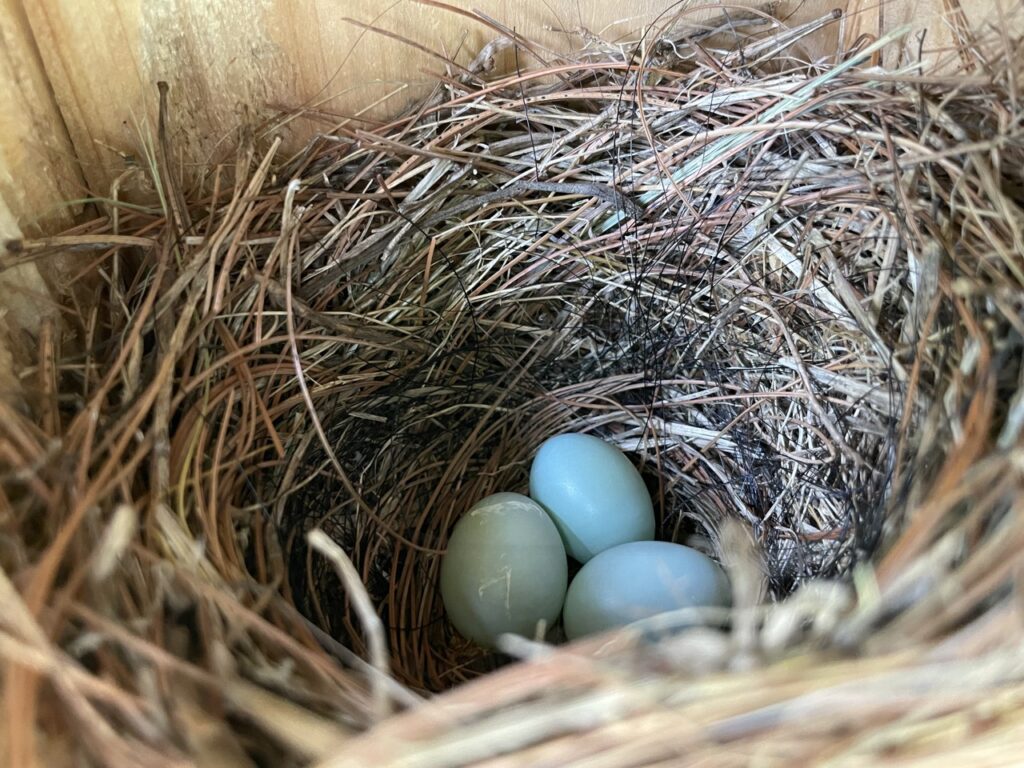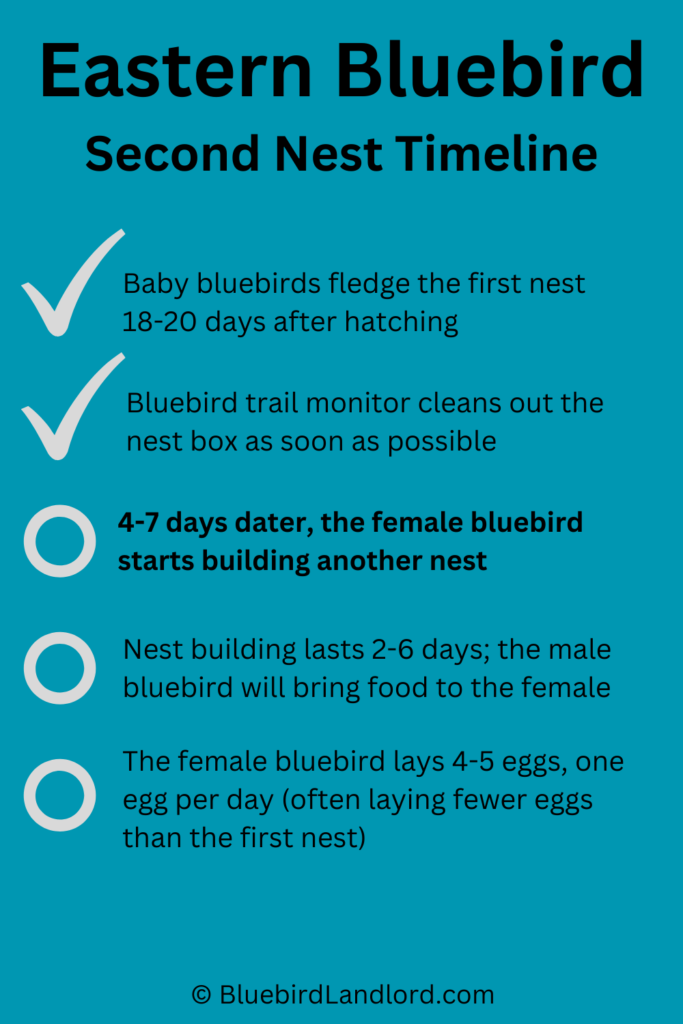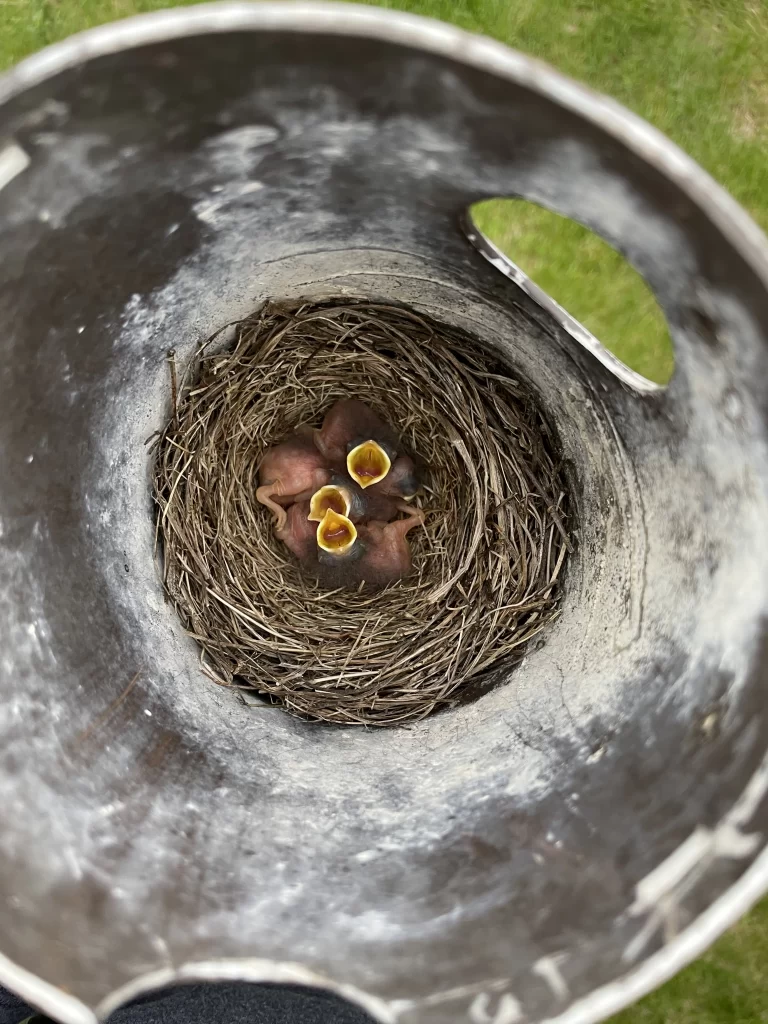
Having your first pair of bluebirds successfully build a nest in your birdhouse and raise their young is an exciting acheivement. Congratulations! You’re an accomplished bluebird landlord. Now that the first clutch of baby blues has left the nest, you are probably getting antsy wondering when a second nest will show up. That’s what we will be talking about today. How soon do bluebirds start a second nest?
As a general rule, bluebirds will start a second nest about 5 days after the first brood of birds has fledged. Bluebirds don’t always build a second nest, unfortunately. If the adult bluebirds find a more attractive nesting site elsewhere, or if they are older/unhealthy, they may not attempt a second nest.
If bluebirds are going to stick around and build another nest at the same site, they will probably start building within a week of the first nest of birds fledging. However, there are multiple reasons that bluebirds might not choose to build a second nest.
In this article, we will discuss when bluebirds typically start building their second nest, why they choose to stay at the same nesting site, and why they might choose not to build a second nest. Let’s start with WHEN bluebirds typically start their second nest.
Eastern Bluebirds: 2nd Nest Building Timeline
Bluebirds almost always start building a second nest about five days after their first brood of birds has fledged. The general timeline can range from 4-7 days. In order to know what to expect from your bluebirds after the first brood of birds leaves the nest, we’ve made the following timeline for you:
| Timeline | What to Expect |
|---|---|
| Day 0 | Baby bluebirds fledge the first nest 18-20 days after hatching |
| Day 1-3 | Bluebird trail monitor cleans out the nest box as soon as possible |
| Day 4-7 | 4-7 days later, the female bluebird starts building another nest |
| Day 9-13 | Nest building lasts 2-6 days; the male bluebird will be seen bringing food to the female and protecting her from predators |
| Day 10-15 | The female bluebird will lay 4-5 eggs, one egg per day. Female bluebirds will often lay fewer eggs in a second or third nest than they lay in the first nest (source). |

Although we want bluebirds to always build a second or third nest in our nest box, there are some good reasons that they choose not to. Let’s go over a few reasons bluebirds may or may not choose to build a second nest.
Reasons Bluebirds Choose to Build a Second Nest
Generally, bluebirds will choose to build a second nest at the same nesting site if they believe they can have another successful brood at that site. It’s all about raising more healthy kids for them! Below are two key reasons bluebirds will choose to build a second nest in your nest box:
1. If it’s still relatively early in the nesting season
Bluebirds only attempt 2-3 nests during the nesting season (early March through early August). So, if a pair of bluebirds fledged a successful nest in March or early April, they will be more likely to attempt a second nest at the same nesting site, since it’s still relatively early in the nesting season.
The closer to the fall it becomes, the less likely it is for your bluebirds to stick around to build another nest.
2. If they had success raising young during their first nest
If bluebirds succeed in raising 3-5 bluebirds in their initial nest, they will be more likely to stick around at the same spot to build a second nest. What they are looking for is nesting success, and if they are confident that your nest box will provide them with success, they’ll want to stick around.
Recommended Reading: Do Bluebirds Return to the Same Nest Box Every Year?

Why Bluebirds Might Choose NOT to Build a Second Nest
Below are a few reasons bluebirds may choose not to build a second nest (or third nest) in your nest box:
1. If the nest box is ridden with parasites
If bluebirds see that a nest box or used nest is infested with parasites, they will be less likely to build a second nest in that location. Bluebird nests sometimes become infested with ants and blowfly larvae during the course of the nesting season. This is a common but unfortunate occurrence that often leads to sick baby bluebirds and nesting failures.
To encourage more second a third bluebird nests in your nest boxes, we recommend cleaning your nest boxes after each time that baby bluebirds leave the nest. We recommend this in order to keep a clean nest box that is free from parasites which will be more attractive to adult bluebirds looking to attempt another nest.
2. If the adult bluebirds are older and/or unhealthy
When adult bluebirds are older or in imperfect health conditions, they can often deal with nest failure more than younger bluebirds. Nest failure can demotivate adult bluebirds and it is just one reason that older/sicker birds may not attempt a second or third nest.
Conclusion
When bluebirds decide to build a second nest at the same nesting site, they usually start around five days after their first brood leaves the nest. However, as we discussed, there are many reasons why bluebirds might not build a second nest.
For example, if the adult bluebird pair is older or less healthy, they may only raise one nest during a given season. On the other hand, if a healthy bluebird pair wants to build a second nest, but they discover a much more attractive nest box somewhere else, they may choose to use that nest box instead.
There are a number of things you can do to encourage bluebirds to stick around for multiple nests (nest box location, deterring predators, cleaning out the nest box, etc.) but ultimately, the birds make the final choice, and despite our best efforts, sometimes they’ll just build one nest per season.
If you are interested in learning more about how to attract bluebirds to your own back yard, click the link above, or check out the rest of our articles here at Bluebird Landlord.


